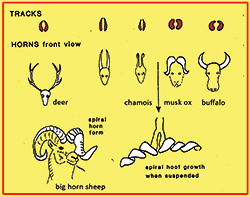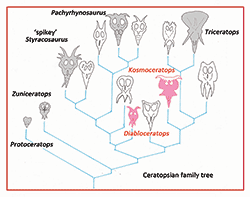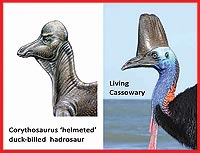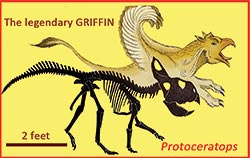 |
| The shapes of horns in large mammals is very variable, and the shapes of tracks mirror horn shape. Similar variation is seen in the horns of some dinosaur groups. |
There are patterns in the anatomy of large animals. Small animals like rodents mostly look quite similar, but large animals like elephants, rhinos, giraffe and moose are anatomically very different, or more “disparate.” These mammal examples have very different head gear, and horn curvature generally matches hoof and track shapes. (Rarely hooves grow into spirals matching spiral horns). The same obvious differences affected many large dinosaurs, especially towards the end of the Cretaceous. Among duckbilled dinosaurs or hadrosaurs Corythosaurus had head gear like a Corinthian helmet and another Lambeosaurus had a three-foot long hollow crest connected to its nostrils, which experiments show would have which produced booming, low frequency sound like a foghorn, good for long-distance communication. But the most flamboyant head gear is found in the horned dinosaurs or ‘ceratopsians’ (meaning horned face) like Triceratops and Pentaceratops (guess how many horns)! It was not just big horns that made them stand out, they also had huge, spiked and ornately fringed frills that look a bit like the ruffs seen in portraits from the time of Queen Elizabeth I. For comparison, the modern cassowary has a helmet-like crest and there is also a bird known as a ruff.
 |
| The Ceratopsian wall at Utah’s Natural History Museum depicts the group’s family tree with full sized skulls. Named forms are mentioned in text: red indicates forms first found in Utah. |
Many ceratopsians like Triceratops (3 horns) and Styracosaurus (spikey face) are common in northern states and provinces east of the Rockies (Wyoming, Montana and especially Alberta). Utah was home to slightly older ceratopsian ancestors with memorable names like Diabloceratops (devilish ceratopsian), Kosmoceratops (ornate face) and Zuniceratops (from the homelands of the Zuni people in New Mexico). Utah’s rich horned dinosaur finds come from the still-remote and largely-roadless Grand Staircase-Escalante National Monument area. It would take a book to detail these treasures, but a summary is found on the Ceratopsian Wall at the Natural History Museum of Utah where 14 complete full-sized skulls are arranged as a family tree. Protoceratops is a famous ancestral form found in Mongolia and famous for two reasons. First: it was found by the 1920s American Museum expedition led by Roy Chapman Andrews, a dashing figure thought to have inspired the Indiana Jones character. Second: in antiquity it gave rise to the concept of the legendary beaked “griffin” that guarded precious mineral mines on the old Silk Road.
Nobody knows why ceratopsians had so many different horns and flamboyant frills, just as no one knows why among hoofed mammals or ungulates the horns of buffalo, deer, sheep and antelope are so different. What we do know is that, besides horns, there are other similarities between these dinosaurs and mammals, including hooves and chewing, molar-like teeth. It is almost as if reptilian dinosaurs tried out designs that mammals adopted a few million years later.
 |
| There are striking similarities between the crests of the dinosaur Corythosaurus and the cassowary bird. |
It used to be thought the horns and frills protected ceratopsians from attack by large carnivores, but studies show the frills were very thin and full of blood vessels, and not like robust armor. Rather, they could have been used as cooling devices, like the elephant’s ears. Some artists have even depicted the frills as brightly colored like the frills and ruffs of birds. This suggests even greater flamboyance and the potential for the frills to have been used for sexual signaling and courtship. Did these dinosaurs perhaps “rut” like elk? Presumably they approached this important reproduction and survival activity “head on.”
 |
| The legendary Griffin was proven to be based on ancient observations of Protoceratops dinosaur skeletons. The frill was mistaken for wings. |
|